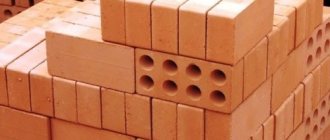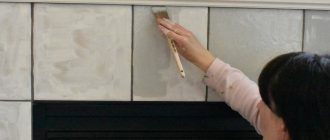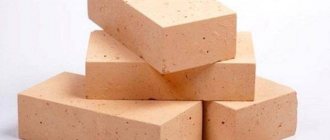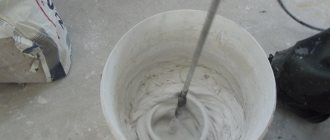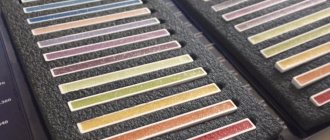Wall cladding with decorative stone continues to be in demand, as it allows you to create the effect of naturalness and luxury. However, after laying the materials, the spaces between them are finished, which makes the composition complete, holistic, and airtight. Grout for decorative stone can be purchased ready-made or prepared independently.
Concept and purpose of grouting
Grout for brick joints is a multi-component composition. It is used after the construction of walls from the appropriate material. It is also used between individual elements of decorative cladding, which is made with tiles. Their use allows you to create an imitation of brickwork. The final stage of this finishing is the sealing of the seams.
Tile material in the form of bricks is an artificial stone. Manufacturers make it based on gypsum or cement. Therefore, it is used for decoration not only indoors, but also outdoors. Finishing materials are available in different designs, including color and size. With its help you can even create an imitation of old brickwork.
Sealing seams between gypsum bricks indoors Source sdelai-lestnicu.ru
More often, grout for decorative bricks is produced in a dry state. Before use, it is diluted with water. The required proportions are always indicated on the packaging. Mixtures that are ready for use are also produced.
Using any type of grouting material for artificial stone allows you to:
- beautifully decorate the seams;
- increase the attractiveness of masonry;
- dilute the picture of the tiled surface, make a more modern and individual finish by using a grout mixture that is different in color from the tile;
- prevent the formation of fungus and mold between bricks;
- reduce the negative impact of temperature changes on tiles in the form of bricks, which will reduce the likelihood of cracks appearing in them;
- create a barrier for moisture through which it will not penetrate to the ends of the tile material;
- reduce the amount of dust accumulating in the seams, which will reduce the likelihood of changing the original color of the cladding.
Sealing the space between artificial finishing stones reduces the amount of accumulated dust Source kraski-net.ru
Manufacturers
For those who prefer to seal the seams with a ready-made mixture, there are many varieties of factory-made mortars, fugues and paints. You can choose a ready-made option for artificial and natural facing bricks, all types of slabs and paving stones, and wild stone finishing. The popular “Ivsil” fugue is available in a wide range of colors and is suitable for exterior and interior use. On average, consumption is 0.5 kg of dry mixture per 1 square meter. for suture gaps 3 mm deep and 4 mm wide.
Classic grouts “Ceresit” and “Polymin” come in white, have different compositions, viscosities and will help isolate the joint ditch from moisture. Consultants at the construction market will help you choose the right brand and type. It should be remembered that polymer compounds are more suitable for interior decoration. Facade work requires cement grouting. For bathrooms there is a special type of insulating mixtures. It is allowed to add colored pigment (red, green) to white material to achieve the required shade to make the masonry look beautiful.
Types and criteria for choosing grouts
To create a beautiful imitation of real brickwork, you need to choose the right composition to fill the empty space between the facing tiles. It is better to use the help of a specialist, for example, a designer who developed the finishing project.
Grout for brickwork joints is available in large quantities. Manufacturers make mixtures using different bases. The following materials are available for sealing brick gaps:
- Gypsum mixtures not for outdoor use. They are designed for indoor use only and are easy to use.
- Silicone elastic compounds providing high tightness.
- Cement coarse or fine-grained mortars , which can be easily redone if cracking occurs.
- Epoxy moisture-resistant mixtures that harden in a short period of time. Therefore, they are recommended for use by professionals who get the job done quickly.
Epoxy grout mixture Source ardex174.ru
See also: Catalog of companies that specialize in finishing materials and related work
- Mixtures with latex plasticizers that increase the adhesion of grouting materials. Such compositions penetrate better into the empty space between finishing tiles in the form of bricks.
- Rubber mixtures with high elasticity and moisture resistance. They are easy to clean from the surface. They are also easy to use.
- Polyurethane compounds resistant to water. After hardening, stains do not form on them. They also differ in their optimal drying time. This allows you to do quality work.
When selecting grout for the seams of decorative bricks, be sure to study the composition of the material. They take into account where it is allowed to be used - exclusively inside the house or also on the street. In addition, when choosing, pay attention to the color of the grout material. Typically, compositions that differ from the main background of the finish are used. The color of the mixture is chosen darker or lighter than the brick tiles.
Thanks to grout of a contrasting color, the tiles do not merge into bricks Source price-altai.ru
Practical recommendations
When preparing the grouting solution yourself, use only sifted components that do not contain large fractions. The solution prepared for use must stand for ten to fifteen minutes, after which it is mixed again to improve the plasticity index.
When grouting, try not to stain the decorative surface of the facing material. If this happens, take immediate measures to remove the contamination.
By following all the recommendations, you can easily cope with the grouting work on your own.
Grouting technologies
When deciding how to seal the seams of decorative bricks, do not forget about the technology for applying the selected material. After all, it depends on its type. There are three popular methods for filling the space between decorative bricks. Each method is performed after preparatory work.
Option 1 - using a syringe gun
This method involves applying the mixture between cement or gypsum-based artificial facing bricks using a special plastic gun. Instead, a regular plastic bag can be used, which, after filling, is rolled into a cone. This method is very convenient and allows you to minimize contamination of already fixed tiles.
Syringe gun Source sense-life.com
The solution application process consists of the following steps:
- cleaning and moistening seams to increase the adhesive properties of materials;
- preparing the mixture if dry grout is used for decorative bricks made of gypsum or cement;
- filling a plastic bag or syringe;
- applying the solution between the tiles by squeezing it out of the tool used;
- Carrying out jointing approximately 15 minutes after laying the mixture;
- removing excess mortar before it dries on the facing material.
On a note! Specialists also pre-prime the seams. This allows you to improve the quality of not only their cleaning, but also the entire final result.
Saving Tips
The cost of grout for decorative stone is considerable, especially for colored mixtures, so care should be taken to use it rationally.
To save you need:
- calculate with particular accuracy the required amount of material so as not to purchase excess;
- For wide joints, it is recommended to use a rubber spatula, which can easily remove excess mixture from the decorative stone and compact it into the cracks.
The accuracy of the procedure is also important, since the diluted composition that gets on the surface quickly sets and will not be able to be used in the future.
It is necessary to select the technology that will help save the mixture as much as possible.
Options for shaping the appearance of seams
If grout is used for gypsum tiles or cement-based bricks, in any case, after filling the gaps, joints are formed. Depending on the method chosen, their appearance will depend. The following formation methods exist:
- Flush.
The easiest option for forming a seam between bricks. The grout mixture is simply leveled to the level of the decorative surface. After this, use a brush with stiff bristles to finish the seams.
- Convex.
This option is implemented when using a spatula with an arcuate edge. It is this side that forms the mixture in the gaps between the facing material.
- Concave.
This type of seam is created using jointing. This is a small spatula. It allows you to fill gaps flush and compact the solution, making its surface concave.
Options for forming seams between bricks Source docplayer.ru
- Beveled.
This method is ideal if grouting is done outdoors. After all, the seam has a bevel, thanks to which water will have less impact on the hardened solution. When forming, a trowel is used. It is with this that the mixture is cut at an acute angle.
- Triangular.
This is a complex version of the execution day. It is implemented indoors and only by craftsmen with relevant experience. The mixture is used to form a triangle between the decorative bricks. Therefore, the gap is not completely filled with solution beforehand.
If work needs to be done outside, choose non-hot days to carry it out. In such weather, the solution will take longer to dry. This allows you to carefully and slowly complete the finishing of building structures.
Popular seam options for outdoors and indoors Source ostroymaterialah.ru
What connections should I make?
The most important parameters for determining which seam is required are:
- By color - the grout should be in harmony with the overall composition and color scheme.
- In width - the calculation is made when laying the decorative stone, then the gap itself is filled. This is necessary to calculate the amount of material consumed.
It will be possible to smooth out seams aesthetically and reliably only where construction and finishing standards were initially observed:
- evenness of the masonry with the same distance between the stones;
- The tiles do not stick out above those lying next to them.
In this case, filling the seams is easy. Construction standards indicate the size of the seam - up to 1 cm, but no more. This will help determine the amount of consumables, for example:
- for a depth and width of 10 mm, you will need from 6 to 8 kg of grout mixture per 1 square meter. m;
- for a standard brick stone measuring 240 by 71 mm, 2.5-3 kg will be needed to process the seams.
When laying, special attention should be paid to the main characteristics of the facing material, since the manufacturers themselves indicate what gap should be left.
Attention
Most mixtures are sold in standard 25 kg bags - this is enough to mash 8-9 square meters. m.
Retainer
Seam fixer is a special solution for working with natural and artificial stone. When facing, it ensures the preservation of gaps of the required size between masonry elements.
Each manufacturer has recommendations for maintaining the gap size and fixing solution. For example:
- for clinker - 10–12 mm;
- for large stones - 15 mm;
- for an irregularly shaped stone - 15–20 mm.
Based on these gap dimensions, manufacturers calculate the consumption rates of stone, grout and fixative.
Retainers are made primarily from extruded polystyrene foam, a flexible, hard material. This is a very useful property when laying artificial stone that has smooth edges.
Briefly about the main thing
Before rubbing the seams on the decorative brick, select a mixture. When selecting it, the composition of the solution and the location of the work are taken into account. The grouting process is carried out using gypsum, silicone, cement, latex, rubber and polyurethane compounds.
I also choose the grouting technology. After all, driving seams can be done using the slurry method, using a syringe gun or spatula. In addition, the method of forming the weld surface is determined. It can have a convex, concave, beveled, triangular shape. It is also made flush with the brick surface.
Ratings 0
How to use?
To fill the seams with your own hands, you will need a set of tools, including a rubber and wooden spatula, and a special device for achieving even filling of gaps - a grout bag. It is useful for aesthetically and quickly processing red decorative bricks and clinker tiles. First, you should dilute the grout and prepare the surface where it will be applied. Then carefully apply the mixture and compact it into the joint gap between the bricks. It is recommended to wipe off the excess immediately, without waiting for it to dry.
Each mixture has its own instructions for use, however, on average, dry compositions are dissolved in a proportion of 1 kg per 200 ml of water. The mass must be homogeneous, so it should be mixed well manually or mechanically. The grout has its best characteristics in the first three hours, then it begins to thicken and loses its elasticity. It is better not to use stale mortar; this can lead to loss of waterproofing of the joints due to microcracks subsequently forming when the mixture dries.
What can you make it from with your own hands?
Budget-friendly, but no less high-quality - making a grout (grout mixture) yourself. Initially, you need to know the main types of grouting components:
- Cement mixtures are simple, easy to prepare, cheap, but high-quality material. To make a fugue, you will need to mix cement mixture (you can use white cement), sand and water in equal proportions. Sand is selected to the smallest fraction. A dye or color of the desired decor color is added to the mixture.
- Gypsum fugue - this composition requires skill, as the gypsum sets quickly. The mixture is made in small portions, which do not have time to harden during work. Gypsum is diluted to a semi-liquid state; slaked lime or 2% of any glue of animal origin is added for strength. Such substances will replace the plasticizer, make the fugu less fragile, and increase the hardening time.
- Alabaster mixture is a type of gypsum, only after additional heat treatment. Alabaster powder is diluted with water to a semi-liquid, thick state, you can add dye. In use it is similar to gypsum composition.
- Clay grout - a grout of this material is made from a clay mass with the addition of a small amount of slaked lime and cement. When hardened, the mixture will be very strong.
Advice
You can buy a ready-made grout mixture and modify it, for example, add the desired color and even glitter. If the design requires a transparent seam made of liquid glass or epoxy, then adding shiny elements will make it more impressive.
A fugue made independently is inferior to industrial compositions, but the quality can be similar. Before mashing, you should make sure that the self-made fugue has the necessary qualities or is close to these parameters:
- elastic, easy to fit at seams;
- after drying, it does not crack, does not crumble, and does not fall apart when cared for;
- the setting time of the composition should be equal to the treatment of one square meter of cladding surface;
- for wet rooms, the composition of the fugue must be moisture resistant;
- the grout mixture must withstand washing with household chemicals;
- aesthetics of the composition: the grout must correspond to the idea and overall design of the facing surface.
Care
Without maintenance of paving slabs, the adhesive or cement base may crack, which will cause premature destruction of the stones. Taking care of the condition of the road surface involves installing a system for draining water from its surface.
It is convenient to care for paving stones using high-pressure devices: car and garden washers. The most popular are street models. Surface cleaning using these devices is carried out using detergents and water, which are supplied under pressure, forming a powerful, narrowly targeted jet.


